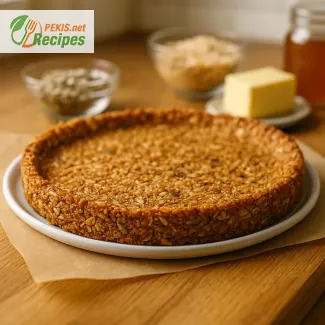
Irresistibly Tender Cake with the Richness of Olive Oil
A timeless dessert that blends Mediterranean simplicity with luxurious flavor
There’s something undeniably elegant about a cake that draws its richness not from butter or cream, but from the fruity depth of extra virgin olive oil. This moist olive oil cake is the perfect example of how a few humble ingredients can create a dessert with stunning flavor, silky texture, and a rustic charm that suits both casual gatherings and special occasions. With its delicate crumb, subtle citrus notes, and glossy golden finish, it’s a recipe that wins over every generation.
While many desserts rely heavily on sugar and fat to impress, this cake goes a different route. The hero ingredient—high-quality olive oil—brings not only moisture but a distinct earthy aroma and gentle bitterness that perfectly balances the sweetness. The result is a cake that’s luxuriously tender, never dry, and boasts a complexity that sets it apart from ordinary sponge or butter-based cakes.
Why olive oil makes this cake unique
Unlike neutral oils or melted butter, olive oil adds character. Its presence in baking is a nod to Mediterranean culinary traditions, where olive oil isn’t just a cooking fat—it’s a foundation of flavor. In this cake, the oil contributes to an exceptionally soft crumb and keeps the texture moist for days, making it ideal for make-ahead desserts or gifts. When paired with citrus zest, almond flour, or even herbs like rosemary or thyme, it takes on a gourmet personality while still being easy to prepare.
Olive oil cake is not just another sweet treat—it’s a refined dessert with a deep sense of place. It recalls the kitchens of southern Italy, coastal Greece, and sun-drenched Spanish villages, where pastries are as much about balance as they are about indulgence. It’s equally at home served with a dusting of powdered sugar, a dollop of whipped mascarpone, or fresh seasonal fruit.
The best ingredients for the best results
What sets a truly great moist olive oil cake apart is the quality of its ingredients. Extra virgin olive oil with fruity or peppery notes works best—its flavor should complement, not overpower. Pair this with organic citrus zest, like lemon or orange, to brighten the richness. Flour should be finely sifted, and if you're feeling adventurous, try replacing a portion with almond flour for a nutty, luxurious finish.
Sugar plays a supporting role here. Instead of dominating the flavor, it brings out the natural sweetness of the oil and citrus. Eggs, at room temperature, are critical for emulsifying the batter and creating the smooth texture that defines this cake.
A versatile cake for every occasion
Whether you're hosting a dinner party or enjoying a quiet weekend, this cake adapts beautifully. Serve it plain for breakfast or brunch, or dress it up with citrus glaze, roasted figs, or a spoonful of lemon curd. Its moist texture and subtle complexity make it suitable for layering or even wedding-style presentation when paired with complementary flavors.
What’s more, olive oil cake is a fantastic option for those seeking dairy-free desserts without sacrificing texture or taste. It remains beautifully moist for several days and actually improves with time as the flavors deepen. In Mediterranean households, it’s not unusual for this kind of cake to sit on the counter under a dome, ready to be served at any moment with a coffee or a glass of dessert wine.
Olive oil cake across cultures
Though often associated with Italy or Greece, olive oil cakes have found their way into countless culinary traditions around the world. In Spain, versions often include orange zest and almonds. In France, lavender or honey may make an appearance. Each interpretation respects the core philosophy: using olive oil to create a moist, balanced, and aromatic cake that lets each ingredient shine.
In modern kitchens, this cake has gained popularity for more than just tradition—it’s embraced for its clean ingredients, rich texture, and the way it bridges simplicity with sophistication. Whether enjoyed warm from the oven or cool with a drizzle of glaze, it offers a sensory experience that’s both comforting and unexpected.
What makes it so moist and flavorful?
The secret lies in emulsification. When you whip eggs and sugar until pale and fluffy before streaming in olive oil, you create a stable base that traps air, giving the cake its light and airy texture. The oil coats the flour proteins, preventing overdevelopment of gluten and ensuring a tender bite. Combined with the natural moisture-retaining power of olive oil, this cake stays soft and luscious for days.
Citrus zest elevates the flavor profile without requiring extracts or artificial flavors. The peel’s essential oils bring a vibrant aroma that pairs beautifully with the mellow richness of the olive oil. A touch of salt enhances both sweet and savory notes, making the overall profile more dynamic.
This cake isn’t just about flavor—it’s about texture, fragrance, and experience. It crumbles delicately yet remains cohesive, melting in the mouth with every forkful.
- Preheat the oven to 175°C (350°F). Lightly grease a 20 cm (8-inch) round cake pan and line the bottom with parchment paper.
- In a medium bowl, whisk together the all-purpose flour, baking powder, and fine sea salt. Set aside.
- In a large mixing bowl, beat the eggs and granulated sugar using an electric mixer on high speed for 3–4 minutes, until the mixture is pale, thick, and airy.
- Add the lemon zest and vanilla extract, and continue beating until well incorporated.
- Reduce mixer speed to low and gradually drizzle in the olive oil, mixing constantly to ensure proper emulsification.
- Add the lemon juice and milk, mixing until smooth.
- Gently fold in the dry ingredients in two parts using a spatula, mixing just until no dry flour remains. Do not overmix.
- Pour the batter into the prepared cake pan and smooth the top.
- Bake in the center of the oven for 45 minutes, or until a toothpick inserted into the center comes out clean.
- Let the cake cool in the pan for 10 minutes, then transfer to a wire rack to cool completely.
- Once cool, optionally dust with powdered sugar before serving.
Creative Upgrades for a Classic Olive Oil Dessert
Transforming your olive oil cake into a masterpiece of flavor and texture
While a moist olive oil cake already delights with its subtle richness and tender crumb, it offers the perfect base for endless variation. With a few strategic tweaks, substitutions, or creative additions, you can elevate this traditional Mediterranean dessert into a personalized and unforgettable creation. From enhancing the flavor complexity to exploring healthier versions, every change tells a new story.
Enhancing the flavor with simple additions
Olive oil has a naturally fruity and slightly peppery profile, which opens up numerous opportunities for pairing. One of the easiest ways to elevate the flavor is by incorporating aromatic elements such as herbs, spices, or extracts.
For instance, adding fresh rosemary or thyme introduces a rustic, herbal depth that perfectly complements the sweetness of the cake. A teaspoon of ground cardamom or cinnamon adds warmth and nuance, especially in cooler months. Using orange zest instead of lemon imparts a more rounded, floral citrus note that works beautifully with the olive oil.
You can also experiment with nut-based flours, such as replacing a portion of the all-purpose flour with almond flour or hazelnut meal. This not only enhances the texture but introduces a subtle nutty undertone that intensifies as the cake rests.
Adding texture and contrast
For those who enjoy contrast in texture, fold-ins can create a more dynamic dessert. Adding a handful of chopped toasted almonds, pistachios, or even sunflower seeds gives each bite a pleasing crunch. If you're aiming for sweetness and complexity, consider mixing in dried fruits like apricots, figs, or raisins soaked in citrus juice or a touch of liqueur.
A layer of fruit compote, such as a blueberry swirl or roasted plum layer, baked directly into the center of the batter can transform the cake into a more luxurious dessert. It also helps to balance the richness of the olive oil with brightness and acidity.
Healthier alternatives that maintain flavor
Replacing ingredients with more health-conscious options doesn’t mean sacrificing enjoyment. Substituting refined sugar with coconut sugar or maple syrup brings a more caramelized sweetness and a lower glycemic index. Using whole grain flour in part (such as spelt or whole wheat pastry flour) increases fiber while maintaining a soft crumb when balanced properly.
To reduce saturated fat even further, plant-based milk like almond, oat, or soy milk can replace whole milk. Vegan versions of the cake can also be achieved using flaxseed eggs and non-dairy yogurt, which both help preserve the moisture and structure.
Why homemade always wins
There’s something incomparable about a homemade olive oil cake. The freshness of ingredients, the absence of preservatives, and the control over every component result in a dessert that feels not only more personal but often tastes superior to any store-bought version. You decide the quality of olive oil, the balance of sweetness, and the type of flour, adapting the cake to dietary needs or flavor preferences.
Homemade also means freedom: the ability to make the cake denser or lighter, sweeter or more savory, or tailored to a specific seasonal ingredient. The aroma of baking olive oil and citrus filling your kitchen is an experience in itself—a celebration of time-honored baking traditions.
Common mistakes to avoid
Even with the best intentions, several missteps can compromise your olive oil cake. One of the most frequent is using low-quality or overly bitter olive oil. Since olive oil is a primary flavor, it should be fresh, fruity, and well-balanced. Avoid olive oils that have turned rancid or taste metallic, as these flaws will be magnified in the final cake.
Another error is overmixing the batter, especially once flour is added. Overworking the batter develops gluten and can lead to a dense, rubbery texture. Gently fold the dry ingredients in until just combined.
Incorrect oven temperature is another pitfall. Baking at too high a heat can cause the cake to brown too quickly on the outside while remaining undercooked in the center. An oven thermometer and consistent heat at 175°C (350°F) are crucial.
Adapting the recipe for special occasions
Though traditionally served plain or with a dusting of powdered sugar, this cake can be elevated for celebrations. Try layering it with a citrus mascarpone cream, or topping it with a glaze made of lemon juice and powdered sugar for an elegant finish. A drizzle of dark chocolate ganache adds richness for winter occasions, while a crown of fresh berries and edible flowers makes it perfect for spring and summer.
You can also infuse the milk with earl grey tea, lavender, or vanilla bean before adding it to the batter, creating subtle undertones that surprise and delight. These elegant touches don’t require much effort but yield impressive results.
Seasonal variations and cultural inspirations
Olive oil cake is incredibly adaptable to the seasons. In autumn, incorporate roasted pear slices or a touch of clove and nutmeg for a cozy twist. In summer, serve it with a spoonful of lemon sorbet or grilled peaches.
Culturally inspired additions also offer fascinating possibilities. In Middle Eastern cuisine, adding orange blossom water or pistachios connects the dessert to ancient baking traditions. In Spanish-style versions, sherry or anise liqueur may be used for added complexity.
No matter how you evolve the recipe, keeping the core of olive oil, citrus, and simple pantry ingredients ensures the spirit of this timeless dessert remains intact—versatile, fragrant, and irresistibly moist.
Allergens present:
- Eggs
- Milk
- Gluten (from wheat flour)
Tips for allergen and gluten replacement:
- Eggs: Replace each egg with 60 g (¼ cup) of unsweetened applesauce or 1 tbsp ground flaxseed + 3 tbsp water (per egg).
- Milk: Substitute with the same amount of almond milk or oat milk.
- Flour (gluten): Use a gluten-free all-purpose flour blend that contains xanthan gum or add 1 tsp xanthan gum if not included.
- Vitamin E: 2.4 mg – supports immune function and skin health
- Calcium: 52 mg – essential for bone health
- Iron: 1.2 mg – supports oxygen transport in the blood
- Magnesium: 14 mg – important for muscle and nerve function
- Potassium: 97 mg – helps regulate blood pressure
- Vitamin B12: 0.4 µg – supports nerve function and red blood cell formation
- Polyphenols from extra virgin olive oil: approx. 150 mg – protect cells from oxidative stress
- Flavonoids from lemon zest: approx. 30 mg – support cardiovascular health and reduce inflammation
- Vitamin C (from lemon juice): 6 mg – strengthens the immune system and improves iron absorption





